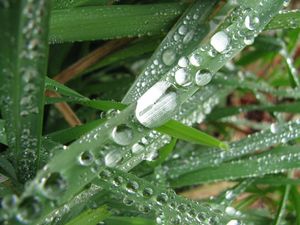What's So Big About Green?
Submitted by Dan MacIsaac
Earle Birney asks, “What’s So Big About Green?” in his poem of that name. Green is huge. Green is the colour of money--which is why one of our major chartered banks has Green Machines, ATMs that spit out greenbacks. Green is the hue of power. It is a brand. Out here on the Left Coast, the Green Party holds the critical three seats that keep the Government in power. Those three members of the BC Legislature are the most skookum trio since the Roman Triumvirate--Caesar, Pompey and Crassus—or The Three Tenors— Domingo, Carreras and Pavarotti. Yep, politics is operatic.
Green is a primary colour in the poetic palette. Poets praise green as the colour of creation. It vivifies the force that drives Dylan Thomas’s “green age.” Regal and relentless, green life conquers cold. Clea Roberts sees "Green crowns of grass/ push through the snow ("Spring Snowfall, Melting"). It is the passionate tone of love. In hunter green, love gives chase (“All in green went my love riding,” ee cummings). Singer and bugler, the huntsman is an artist—and an emblem of passion and destruction:
Four tall stags at the green mountain
the lucky hunter sang before.
He is evergreen, constant in his pursuit of lovely life and beautiful death. For Robert Burns, like ee cummings, eros allows the sweetest hours. To adapt Kissinger’s phrase, green is the great aphrodisiac. The vivid chorus of one of the Scot’s finest lyrics proclaims:
Green grow the rashes, O;
Green grow the rashes, O;
The sweetest hours that e’er I spend,
Are spent among the lasses, O.
The hue and cry of precarious love is green in Lorca’s ballad, “Romance sonámbulo”:
Your CanLit News
Subscribe to Open Book’s newsletter to get local book events, literary content, writing tips, and more in your inbox
Verde que te quiero verde.
Verde viento. Verdes ramas.
The gypsy girl, moonlit, drowns in a cistern. A lost exotic, the girl is green-haired as a legendary siren. But water destroys her.
Green can be the colour of peril, of twisted jealousy, the Shakespearean “green-eyed monster.” It is certainly the colour of possession. An early English lyricist asks,
Who shall have my fair lady?
Who shall have my fair lady?
Who but I, who but I, who but I?
Under the leaves green!
Repetition of words and questions underscores the obsessive nature of the singer.
Green can also exude expulsion and loss. Méira Cook’s “Young Eve” states flatly, “Some loose/ green fuse tripped our intention” (“Cracked”). Young girl and boyfriend look “for a place to park” “north along the highway” “in his daddy’s pickup.” Outside the garden, passion becomes assault.
But green can be a holy, restorative place. Guided to “green pastures” (Psalm 23), the fearful psalmist is consoled. The 17th century Mexican nun and muse, Sor Juana Inés de la Cruz, mistrusts nature and the flesh as “loca Esperanza” (Mad Hope). Ironically, her denunciation of worldly beauty highlights its loveliness. William Blake takes the opposing view, denouncing the ossified Church. He divorces “green” spirituality from organized religion. His song, “The Garden of Love,” laments:
A Chapel was built in the midst,
Where I used to play on the green.
His green is a place of innocence and a shade of purity. The green spirit is opposed to restrictive religion, although, ironically, his “priests in black gowns,” bind with “briars,” crooked and barbed forms of greenery. Yet, for the Hebrew bard, the green where he dwells, restored, is “the House of the Lord” (Psalm 23). The flesh and the spirit are not at odds on the Edenic meadow. This holistic perspective is also assumed by John Barton in West of Darkness, his collection of poems about Emily Carr. Barton’s Carr “views the natural world of the Pacific Northwest as a sentient, benevolent force that is the incarnate expression of her God” (“My Emily Carr”). The green leaves of the arbutus here are “lucid” (“Laughing Forest”). Cedars are “banks of sea-green flame” (“Big Raven”).These poems conjure up the mystical jades, jaspers and serpentines of Carr’s forest paintings.
Green is big—cosmic, coming in multivalent shades both subtle and loud. For poets, this colour is kaleidoscopic in tone and nuance.
The views expressed in the Writer-in-Residence blogs are those held by the authors and do not necessarily reflect the views of Open Book.
Raised on Vancouver Island, Dan MacIsaac is a third-generation lawyer and served for ten years as a director on the board of the Environmental Law Centre at the University of Victoria. His poetry, verse translations, and fiction have appeared in a wide variety of literary journals and magazines. One of his stories was short-listed for the 2009 CBC Literary Awards, one of his poems received the 2014 Foley Prize from America Magazine, and another poem was short-listed for the 2015 Walrus Poetry Prize. He lives in Victoria. Cries from the Ark is his first poetry collection.


